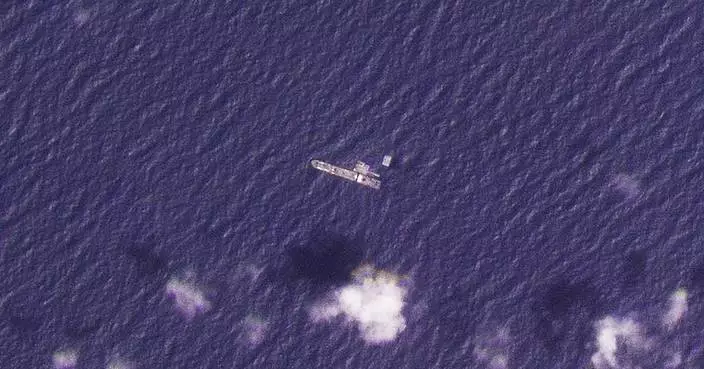A disciplinary panel dismissed ethics charges Friday against the Arkansas Supreme Court's justices over their decision to prohibit a judge who participated in an anti-death penalty demonstration from hearing any execution-related cases.
The Arkansas Judicial Discipline and Disability Commission voted unanimously to dismiss the charges that the court's seven justices violated ethics rules when they disqualified Pulaski County Circuit Judge Wendell Griffen. The court last year prohibited Griffen from hearing death penalty cases after he was photographed laying on a cot during a demonstration outside the governor's mansion wearing an anti-death penalty button and surrounded by people holding signs opposing executions.
Earlier the day of the demonstration, Griffen blocked the state from using a lethal injection drug over the claims the drug supplier had been misled by the state.
A three-member panel earlier this year said the justices never gave Griffen notice or an opportunity to be heard over his removal. In dismissing the complaint Friday, the commission said it doesn't have jurisdiction to take action against judges for how they apply the law in the absence of "fraud, corrupt motive or bad faith." The justices had argued the commission didn't have jurisdiction over the complaint since it dealt with a legal issue and not an ethical matter.
The ethics complaint against the justices was filed by Griffen, who was charged earlier this year by a three-member panel from the commission over the demonstration. An attorney for Griffen said he was surprised by the commission's action and had not been notified beforehand.
"This clandestine Friday afternoon dismissal of the sustained ethics charges against the Arkansas Supreme Court was totally unknown to us until now because we were not given any notice of a hearing or session regarding same," attorney Mike Laux said in an email. "Unfortunately, this appears to be a recurring theme when it pertains to Judge Griffen's constitutional rights and protected interests."
Brent Standridge, the special counsel who had been appointed to prosecute the case against the justices, did not immediately return a call Friday afternoon.
Five justices had filed a lawsuit in the state Supreme Court to halt the ethics charges. Gov. Asa Hutchinson last month named seven special justices to preside over that case.
Griffen had sued the justices over his disqualification, claiming it violated his constitutional rights, but a federal appeals court dismissed the case. Griffen's ethics case is scheduled to go before the full commission in March.
Follow Andrew DeMillo on Twitter at www.twitter.com/ademillo
WASHINGTON (AP) — The U.S. and allies are scrambling to pull together a complex system that will move tons of humanitarian aid into Gaza by sea. Nearly two months after President Joe Biden gave the order, U.S. Army and Navy troops are assembling a large floating platform several miles off the Gaza coast that will be the launching pad for deliveries.
But any eventual aid distribution — which could start as soon as early May — will rely on a complicated logistical and security plan with many moving parts and details that are not yet finalized.
The relief is desperately needed, with the U.N. saying people in Gaza are on the brink of famine. But there are still widespread security concerns. And some aid groups say that with so much more needed, the focus should instead be on pushing Israel to ease obstacles to the delivery of aid on land routes.
Setting up the system is expected to cost at least $320 million, the Pentagon said Monday. Here's how it will work:
Humanitarian aid bound for Gaza through the maritime route will be delivered by air or sea to Cyprus, an island at the eastern edge of the Mediterranean Sea.
Cyprus Foreign Minister Constantinos Kombos has said the aid will undergo security checks at Larnaca port. Using that one departure point will address Israel's security concerns that all cargo be inspected to ensure that nothing is loaded on ships that Hamas could use against Israeli troops.
The screening will be strict and comprehensive, including the use of mobile X-ray machines, according to a Cyprus government official who spoke on condition of anonymity to publicly disclose details about the security operation. The process will involve Cypriot customs, Israeli teams, the U.S. and the United Nations Office for Project Services.
An American military official said the U.S. has set up a coordination cell in Cyprus to work with the government there, the U.S. Agency for International Development and other agencies and partners. The group will focus on coordinating the collection and inspection of the aid, said the official, who also spoke on condition of anonymity to discuss operation details.
Once the pallets of aid are inspected, they will be loaded onto ships — mainly commercial vessels — and taken about 200 miles to the large floating pier being built by the U.S. military off the Gaza coast.
There, the pallets will be transferred onto trucks that in turn will be loaded onto two types of smaller Army boats — Logistic Support Vessels, or LSVs, and Landing Craft Utility boats, LCUs. The U.S. military official said the LSVs can hold 15 trucks each and the LCUs about five.
The Army boats will then shuttle the trucks from the pier to a floating causeway, which will be several miles away and anchored into the beach by Israeli Defense Forces.
Since Biden has made clear that no U.S. forces will step foot in Gaza, the troops doing the construction and driving and crewing the boats will be housed and fed on other ships offshore near the large floating pier.
The British Royal Navy support ship RFA Cardigan Bay will provide accommodations for hundreds of U.S. sailors and soldiers working to establish the pier. Another contracted ship will also be used for housing, but officials did not identify it.
The small Army boats will sail to the two-lane, 550-meter (1,800-foot) causeway.
The U.S. military official said an American Army engineering unit has teamed up with an Israeli engineering unit in recent weeks to practice the installation of the causeway, training on an Israeli beach just up the coast. The U.K. Hydrographic Office also has worked with the U.S. and the Israeli military to analyze the shoreline and prepare for the final installation.
U.S. vessels will push the floating causeway into place, shoving it into the shoreline, where the Israeli Defense Forces will be ready to secure it.
Trucks loaded with the pallets of aid will drive off the Army boats onto the causeway and down to a secure area on land where they will drop off the aid and immediately turn around and return to the boats. The trucks will repeat that loop over and over, and they will be confined to that limited route to maintain security.
They will be driven by personnel from another country, but U.S. officials have declined to say which one.
Aid groups will collect the supplies for distribution on shore, at a port facility built by the Israelis just southwest of Gaza City. Officials say they expect about 90 truckloads of aid a day initially and that it will quickly grow to about 150 a day.
The U.N. is working with USAID to set up the logistics hub on the beach.
There will be three zones at the port: one controlled by the Israelis where aid from the pier will be dropped off, another where the aid will be transferred and a third where Palestinian drivers contracted by the U.N. will wait to pick up the aid before taking it to distribution points.
Aid agencies, however, say this maritime corridor isn't enough to meet the needs in Gaza and must be just one part of a broader Israeli effort to improve sustainable, land-based deliveries of aid to avert famine.
The groups, the U.N., the U.S. and other governments have pointed to Israel's aid restrictions and its failure to safeguard humanitarian workers as reasons for the reduction in food shipments through land crossings, although they credit Israel with making some improvements recently.
U.S. Gaza envoy David Satterfield said last week that only about 200 trucks a day were getting into Gaza, far short of the 500 that international aid organizations say are needed.
A key concern is security — both from militants and the Israeli military, which has been criticized for its killing of aid workers.
Sonali Korde, a USAID official, said key agreements for security and handling the aid deliveries are still being negotiated. Those include how Israeli forces will operate in Gaza to ensure that aid workers are not harmed.
Aid groups have been shaken by the Israeli airstrike that killed seven World Central Kitchen aid workers on April 1 as they traveled in clearly marked vehicles on a delivery mission authorized by Israel.
And there has already been one mortar attack at the site by militants, reflecting the ongoing threats from Hamas, which has said it would reject the presence of any non-Palestinians in Gaza.
U.S. and Israeli officials have declined to provide specifics on the security. But the U.S. military official said it will be far more robust when deliveries begin than it is now. And there will be daily assessments of the force protection needs there.
The IDF will handle security on the shore, and the U.S. military will provide its own security for the Army and Navy forces offshore.
Associated Press reporters Menelaos Hadjicostis in Nicosia, Cyprus, and Ellen Knickmeyer in Washington contributed.
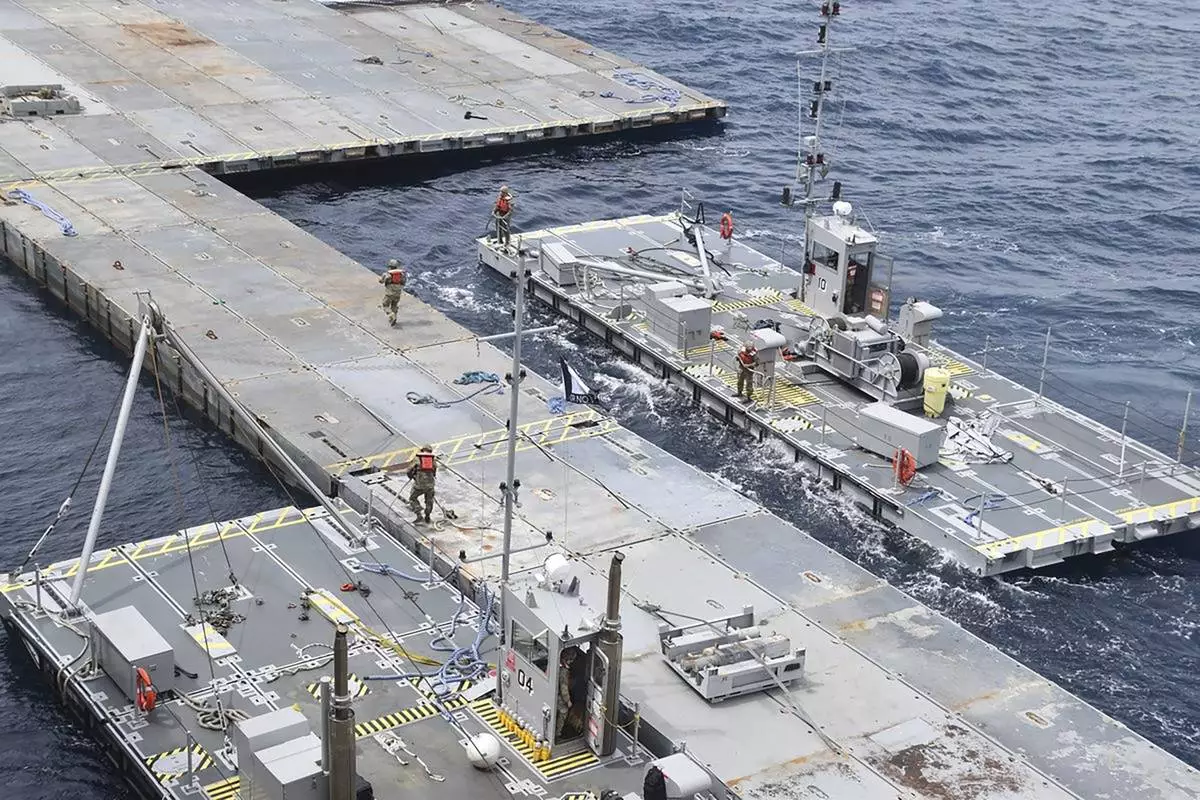
This undated photo released early Tuesday, April 30, 2024, by the U.S. military's Central Command shows construction off a floating pier in the Mediterranean Sea off the Gaza Strip. A U.S. Navy ship involved in the American-led effort to bring more aid into the besieged Gaza Strip is off shore from the enclave, slowly building out a floating platform for the operation, satellite photos analyzed Monday, April 29, 2024, by The Associated Press show. (U.S. military's Central Command via AP)
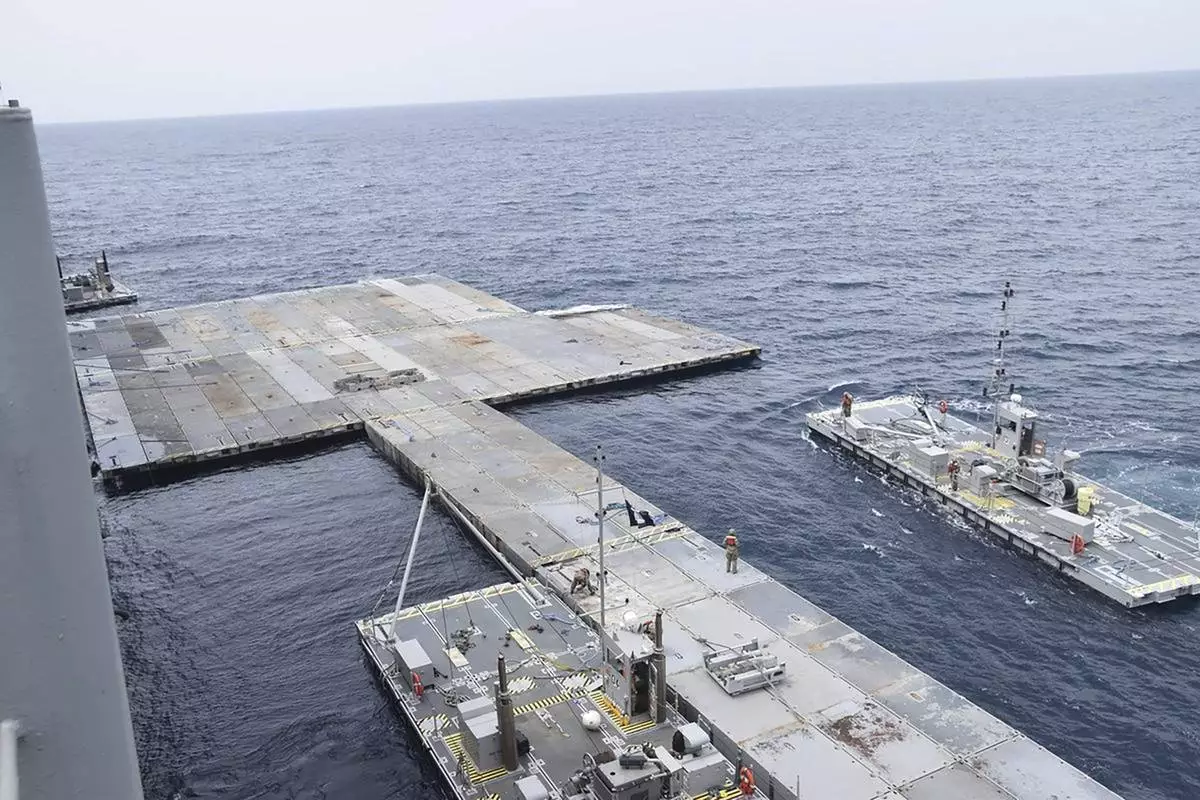
This undated photo released early Tuesday, April 30, 2024, by the U.S. military's Central Command shows construction off a floating pier in the Mediterranean Sea off the Gaza Strip. A U.S. Navy ship involved in the American-led effort to bring more aid into the besieged Gaza Strip is off shore from the enclave, slowly building out a floating platform for the operation, satellite photos analyzed Monday, April 29, 2024, by The Associated Press show. (U.S. military's Central Command via AP)
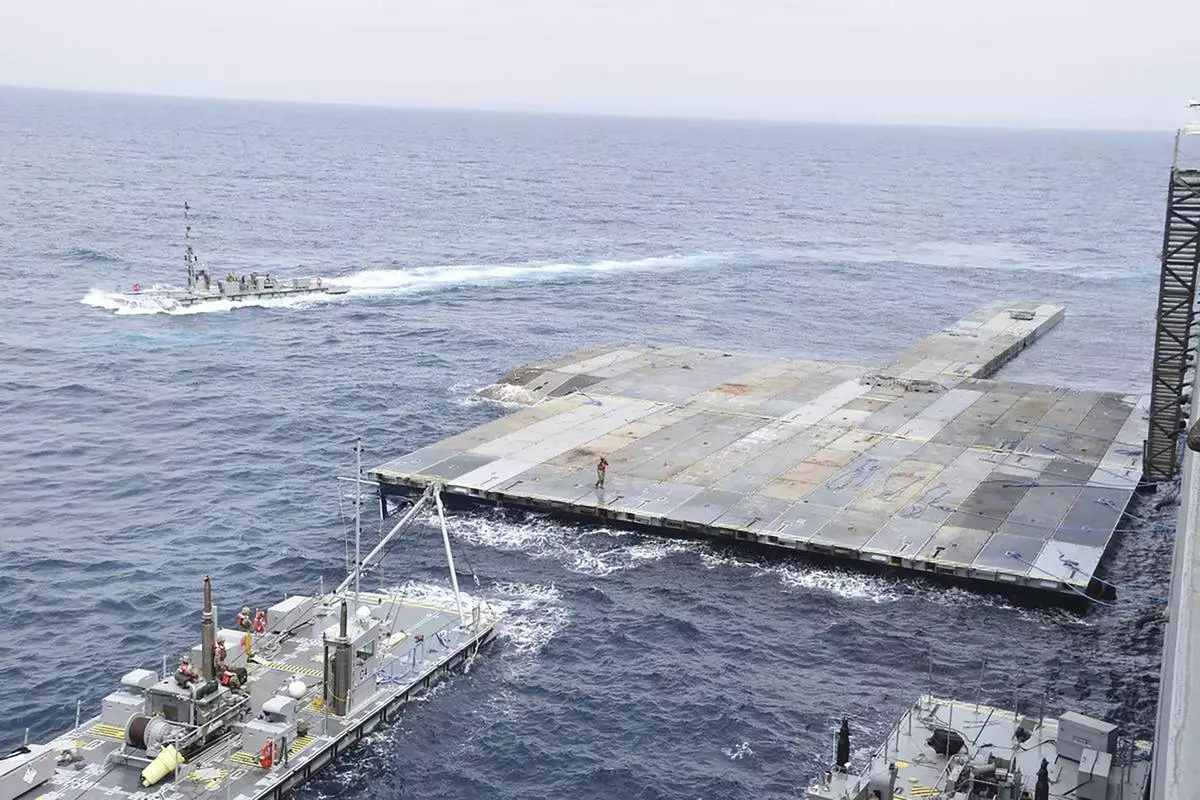
This undated photo released early Tuesday, April 30, 2024, by the U.S. military's Central Command shows construction off a floating pier in the Mediterranean Sea off the Gaza Strip. A U.S. Navy ship involved in the American-led effort to bring more aid into the besieged Gaza Strip is off shore from the enclave, slowly building out a floating platform for the operation, satellite photos analyzed Monday, April 29, 2024, by The Associated Press show. (U.S. military's Central Command via AP)
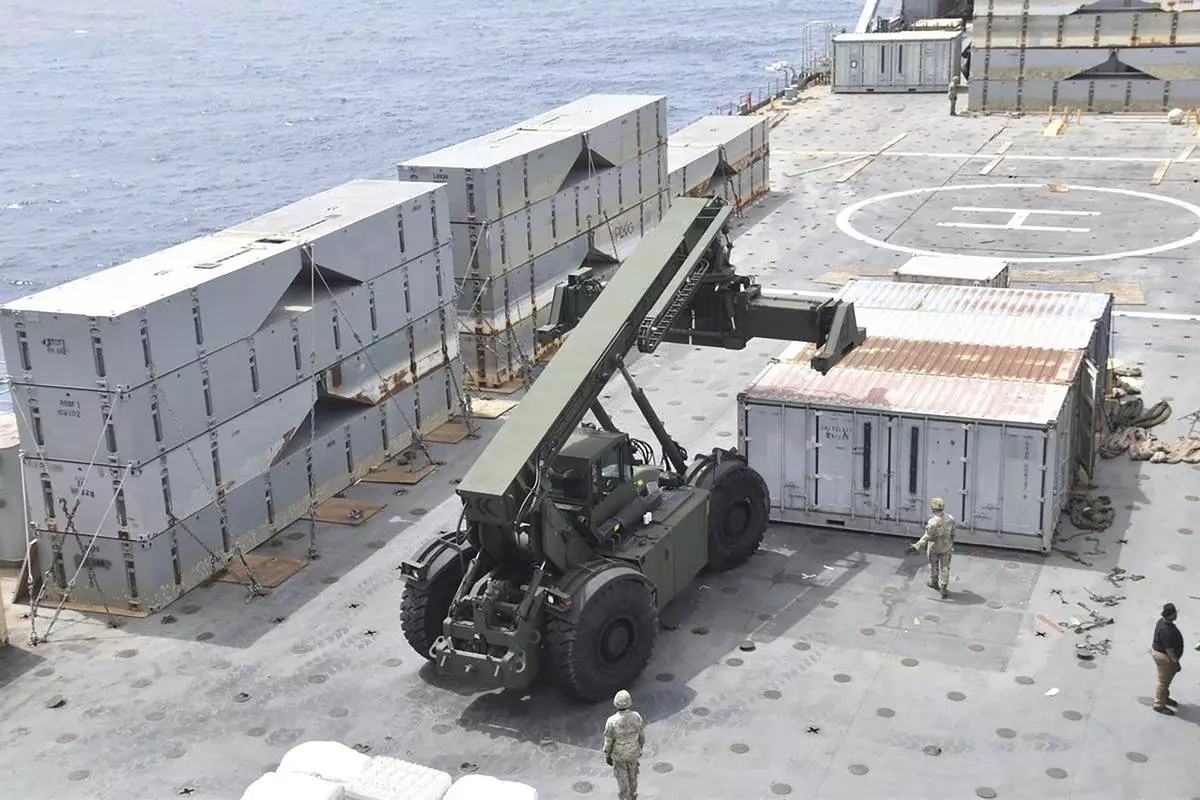
This undated photo released early Tuesday, April 30, 2024, by the U.S. military's Central Command shows construction off a floating pier in the Mediterranean Sea off the Gaza Strip. A U.S. Navy ship involved in the American-led effort to bring more aid into the besieged Gaza Strip is off shore from the enclave, slowly building out a floating platform for the operation, satellite photos analyzed Monday, April 29, 2024, by The Associated Press show. (U.S. military's Central Command via AP)







